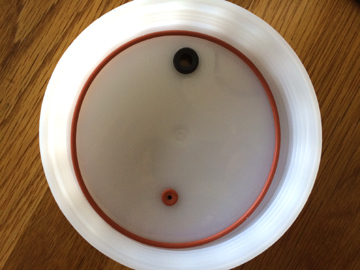I made a few one gallon batches and just like many others I was bitten by the brew bug (bbtbb).
I did a lot of research and frankly was overwhelmed by the amount of brew equipment available to home brewers. Now dont get me wrong I love gadgets and using my hands but for some reason I decided to try and keep my brewing process as simple as possible. So I bought the FastFerment.
Im currently fermenting my first five gallon batch. Its a West Coast IPA, lots of yummy hops.
Last night it was time to drop the collection ball. I couldnt get the union fitting apart with my hands only. I ended up using a large pair of channel locks on the screw while holding the valve with my other hand. That did the trick, but I wasnt expecting that. Also like many others have written the o-ring from the top of the union valve came off. No big deal.
The collection ball was filled with sediment just like I hoped. The sediment in the collection ball was really thick with almost a peanut butter consistency.
So using warm water I got the collection ball and o-ring cleaned and then sanitized them. I have co2 so I purged the collection ball with it and reattached it to the FF. Now to turn open the valve and watch the large bubbles flow to the top. Here we go
Nothing.
I can see a line of what must be more of this thick sediment sitting in the bottom of the conical, like 4-5 inches of it. This was a serious clog. To me theres no way any air bubble from the collection ball will penetrate that load. I tapped the bottom of the conical to see if I could get the sediment to flow into the collection ball but it didnt budge. I ended up sanitizing a long plastic stick and from the top of the conical pushed through the sediment. Eventually the collection ball did fill.
Ive since read on this forum that if I just leave it alone in a few days gravity will eventually pull the sediment down into the collection ball. Is that true?
Im not going to give up on the FF yet. I can always find a work around for issues I have along the way. But like I said in the beginning I want this process to be as simple as possible and maybe buckets and racking is the way to go?
Some questions I have are:
Should I expect these types of issues each time I use the FF?
Ive read I should leave the valve closed while transferring the wort to the FF. Then after the solids settle for a few hours purge them using the hose until you get clear wort, then attach the collection ball and pitch. If I do it this way will it prevent the clogging issue I saw?
Where does this thick sediment come from, Yeast Hops or both?
After replacing the collection ball if there is a clog will gravity eventually pull that thick sediment down into the collection ball?
When using the FF Should I only ferment certain types of beer? Less hoppy?
Maybe the FF better suited for wine making?
Id really like to hear back from other FF brewers on if what is happening to me is normal or am I doing things incorrectly?











![Craft A Brew - Safale S-04 Dry Yeast - Fermentis - English Ale Dry Yeast - For English and American Ales and Hard Apple Ciders - Ingredients for Home Brewing - Beer Making Supplies - [1 Pack]](https://m.media-amazon.com/images/I/41fVGNh6JfL._SL500_.jpg)






















































